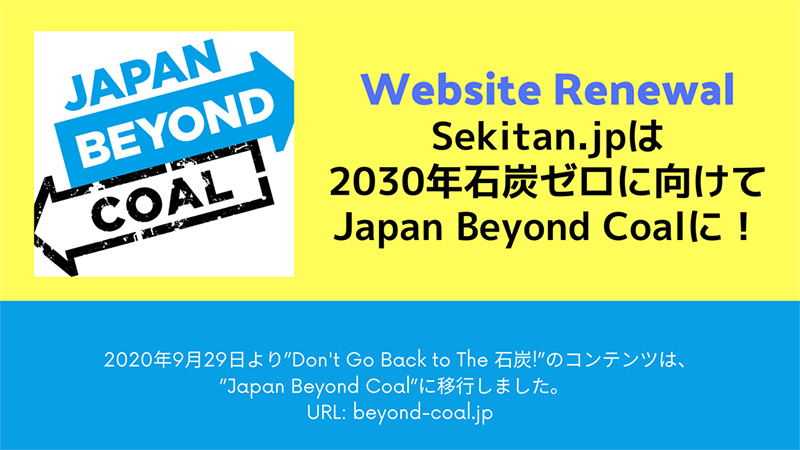[:ja]
レポートのご案内:世界中で失敗が続く「クリーンコール」技術を押し進める日本
2016年11月14日
(マラケシュ/東京) 新たな分析によれば、日本は海外の石炭事業に10億ドルの投融資を行うことを計画している。さらに、日本の環境NGO気候ネットワークによると、画期的な分析でも既に世界では失敗したと見なされている石炭技術を日本が今も推進していることが示されているとしている。[1]
日本は国内で48基の石炭火力発電所の建設を計画しており、新規の石炭火力発電所の建設が2℃目標の達成と矛盾することに疑いの余地がないにも関わらず、「高効率・低排出(HELE: High Efficiency Low Emissions)」石炭火力発電所が気候変動の解決策になると主張している。[2]
気候ネットワークの平田仁子理事は
「日本政府代表は、今頃になってパリ協定を批准しておきながら、この期に及んで気候変動を加速させる石炭火力発電所の新規建設に対し巨額の資金(日本円)を国内および海外に投じることにより、パリ協定を弱体化させていることを恥じるべきである。日本政府は、太陽光や風力発電に支援することで最先端の技術開発を後押しすることもできるのに、石炭火力に執着していたビクトリア時代に残り続ける決心をしたようにすら思える」と述べている。
この報告書では、HELE技術の一つである石炭ガス化複合発電(IGCC)を取り上げている。IGCC発電所では、石炭をガス化し、生成ガスを作り出し、このガスをタービンの動力として用いることで発電している。
IGCCは、石炭を直接燃焼するより効率が良く、汚染物質の排出も少ない。国際的なデータには、従来の標準的な石炭火力発電所の発電効率は最大でも38%と記されているのに対し、IGCCの発電効率は45〜50%まで向上すると見込まれる。日本の産業界のデータによれば、全体的に見た場合のIGCC発電所からのCO2排出量は、従来の石炭火力発電所よりも約20%削減になる。
IGCCの第1の問題はコストが高いことである。米国エネルギー情報局(EIA)の試算によれば、IGCC石炭火力発電所の建設コストは発電量100万kWあたり約44億ドルにもなる。この金額は従来の石炭火力発電所より35%ほどコスト高となる。第2に、IGCCは複雑で建設が難しいことが挙げられる。その上、IGCC発電所の運用がうまくいっているのかを証明することは容易ではない。第3に、IGCC発電が従来型より高効率であったとしても、高レベルの汚染源であることには変わりがない。石炭は化石燃料の中でも最も汚いので、石炭からのCO2排出をこれから20%削減するという水準は、気候変動への影響を押さえるためにはささやかなものである。
新規の発電所は必要ない。2015年の日本の電力需要は、経済成長の鈍化およびエネルギーの効率化により5年連続で減少している。
特に太陽光や風力などの代替え再生可能エネルギーへの将来性は拡大している。
以上
別添資料
別添資料 世界のIGCC発電所計画(Ecel)
注釈
[1] 日本が新規石炭発電事業に10億ドルもの投融資を行い、パリ協定を弱体化させているという保留中の発表と同様の内容は、NRDC(Natural Resources Defense Council: 自然資源保護協議会)の新しい石炭の海外支援に関する分析としても公開されている。 www.nrdc.org
[2] Ecofys(エネルギーに関するシンクタンク)が2016年7月に発表した報告書「高効率の石炭技術は 2℃シナリオと矛盾(原題:The Incompatibility of High-Efficient Coal Technology with 2 ºC Scenarios)」より
同報告書プレスリリース(日本語PDF)
[3] IEEFA(Institute for Energy Economics and Financial Analysis: エネルギー経済・財務分析研究所)が2016年3に発表した報告書「IEEFA(エネルギー経済・財務分析研究所)ブリーフィングペーパー(原題:IEEFA Japan Briefing: Japan’s Energy Transformation)」より
同報告書プレスリリース(日本語リンク)
レポート(PDF)
レポート(和文):気候ネットワーク レポート「世界中で失敗が続く IGCC (石炭ガス化複合発電) 高コストで、大量のCO₂を排出」(PDF)
レポート(英文):Kiko Network Paper ”Universal failure: How IGCC coal plants waste money and emissions” (PDF)
問合せ:特定非営利活動法人 気候ネットワーク(http://www.kikonet.org)
【東京事務所】〒102-0082 東京都千代田区一番町9-7一番町村上ビル6F
TEL: 03-3263-9210、FAX:03-3263-9463、E-mail:tokyo@kikonet.org
【京都事務所】〒604-8124 京都府京都市中京区帯屋町574番地高倉ビル305
TEL: 075-254-1011、FAX:075-254-1012、E-mail:kyoto@kikonet.org
[:en]
New report: Japan champions ‘clean’ coal technology despite ‘universal failure’
November 14th, 2016
(Marrakesh/Tokyo). As new analysis reveals that Japan plans to invest US$10 billion into coal projects overseas, ground breaking analysis also shows that Japan is promoting coal technology which has failed universally, according to Japanese NGO Kiko Network.[1]
Japan is also planning to build 48 coal power plants at home, claiming that ‘high efficiency, low emissions’ (HELE) coal power stations are a solution to climate change, despite the incontrovertible evidence that building new coal power plants is incompatible with the two degree temperature target.[2]
Director of Kiko Network, Kimiko Hirata said:
“Japanese government representatives should hang their heads in shame as they have now ratified the Paris Climate Accord but plan to undermine it by wasting hundreds of billions of Yen on new climate-destroying coal plants in Japan and across the world. The Japanese government could be at the cutting edge of technological innovation by investing in solar and wind but it seems determined to be left behind with its Victorian age obsession with coal firing.”
The report deals specifically with Integrated Gasification Combined Cycle (IGCC), one form of HELE technology. In IGCC power plants, coal is gasified, creating a form of gas known as syngas. This is then used to power a turbine, creating electricity.
IGCC is a more efficient way of generating power than burning the coal directly, and therefore less polluting. A standard coal plant converts up to 38% of the coal’s energy to power, according to international data. IGCC technology can raise this figure to 45 – 50%. Overall, IGCC plants emit around 20% less carbon dioxide than conventional coal plants, according to Japanese industry data.
But IGCC is expensive. The US Energy Information Administration estimates that an IGCC coal plant costs around $4.4 billion per gigawatt of capacity to build, making it about 35% more costly than a conventional coal plant. Secondly, IGCC plants are complicated and difficult to build, and getting plants to operate successfully has not proven easy. Thirdly, even though IGCC coal plants are more efficient than conventional coal plants, they are still highly polluting. Reducing coal’s emissions by an additional 20% will have a limited impact on its contribution to climate change, as the most polluting fossil fuel.
The new plants may not even be needed. Electricity demand in Japan fell for the fifth consecutive year in 2015, as a result of weak economic growth and energy efficiency measures.[3] There is major potential for renewable alternatives especially solar and wind.
ENDS
Reference Data
Reference IGCC power generation plan(Excel)
Notes to Editors
[1] NRDC are launching new analysis on coal finance overseas to the same embargo revealing that Japan plans to invest US$10 billion into new coal projects, undermining the Paris Agreement. www.nrdc.org
[2] Ecofys, The incompatibility of high efficient coal technology with 2°C scenarios, July 2016 (PDF)
[3] IEEFA, IEEFA Japan Briefing: Japan’s Energy Transformation, 2016 (PDF)
Download the file here (PDF)
Paper (English): Kiko Network Paper ”Universal failure: How IGCC coal plants waste money and emissions” (PDF)
Press Release (Japanese):レポートのご案内 世界中で失敗が続く「クリーンコール」技術を押し進める日本 (PDF)
Paper (Japanese):気候ネットワーク レポート「世界中で失敗が続く IGCC (石炭ガス化複合発電) 高コストで、大量のCO₂を排出」(PDF)
Contacts
Kiko Network (www.kikonet.org)
Tokyo office TEL: +81-3-3263-9210+81-3-3263-9210, E-mail:tokyo@kikonet.org
Kyoto office TEL: +81-75-254-1011+81-75-254-1011, E-mail:kyoto@kikonet.org
[:]

